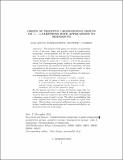Orbits of primitive k-homogenous groups on (n-k)-partitions with applications to semigroups
Abstract
The purpose of this paper is to advance our knowledge of two of the most classic and popular topics in transformation semigroups: automorphisms and the size of minimal generating sets. In order to do this, we examine the k-homogeneous permutation groups (those which act transitively on the subsets of size k of their domain X) where |X|=n and k<n/2. In the process we obtain, for k-homogeneous groups, results on the minimum numbers of generators, the numbers of orbits on k-partitions, and their normalizers in the symmetric group. As a sample result, we show that every finite 2-homogeneous group is 2-generated. Underlying our investigations on automorphisms of transformation semigroups is the following conjecture: If a transformation semigroup S contains singular maps, and its group of units is a primitive group G of permutations, then its automorphisms are all induced (under conjugation) by the elements in the normalizer of G in the symmetric group. For the special case that S contains all constant maps, this conjecture was proved correct, more than 40 years ago. In this paper, we prove that the conjecture also holds for the case of semigroups containing a map of rank 3 or less. The effort in establishing this result suggests that further improvements might be a great challenge. This problem and several additional ones on permutation groups, transformation semigroups and computational algebra, are proposed in the end of the paper.
Citation
Araújo , J , Bentz , W & Cameron , P J 2019 , ' Orbits of primitive k -homogenous groups on ( n - k )-partitions with applications to semigroups ' , Transactions of the American Mathematical Society , vol. 371 , no. 1 , pp. 105-136 . https://doi.org/10.1090/tran/7274
Publication
Transactions of the American Mathematical Society
Status
Peer reviewed
ISSN
0002-9947Type
Journal article
Description
This work was developed within FCT project CEMAT-CIÊNCIAS (UID/Multi/04621/2013).Collections
Items in the St Andrews Research Repository are protected by copyright, with all rights reserved, unless otherwise indicated.

